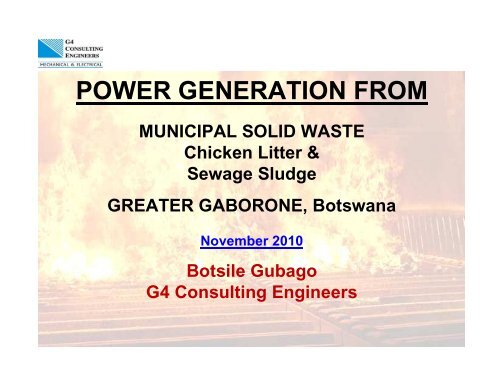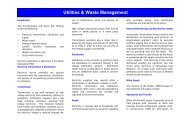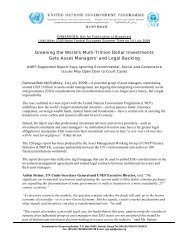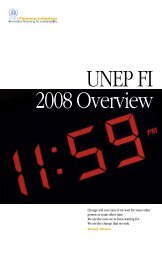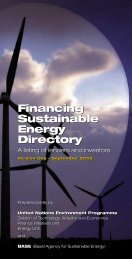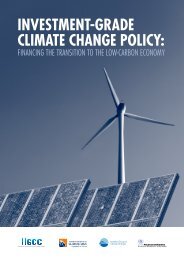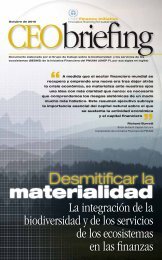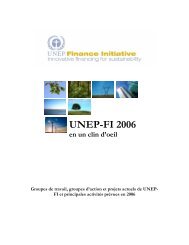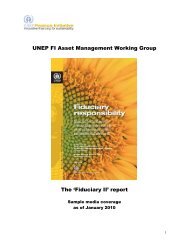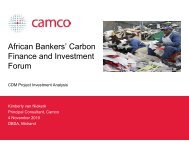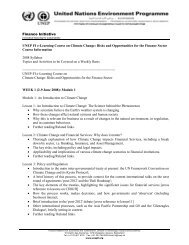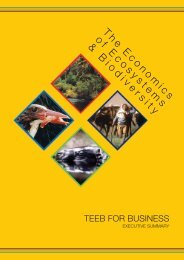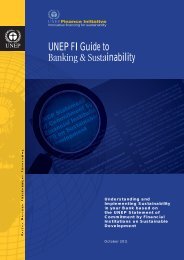Chicken Litter and Sewage Sludge Power Generation in Greater ...
Chicken Litter and Sewage Sludge Power Generation in Greater ...
Chicken Litter and Sewage Sludge Power Generation in Greater ...
Create successful ePaper yourself
Turn your PDF publications into a flip-book with our unique Google optimized e-Paper software.
POWER GENERATION FROM<br />
MUNICIPAL SOLID WASTE<br />
<strong>Chicken</strong> <strong>Litter</strong> &<br />
<strong>Sewage</strong> <strong>Sludge</strong><br />
GREATER GABORONE, Botswana<br />
November 2010<br />
Botsile Gubago<br />
G4 Consult<strong>in</strong>g Eng<strong>in</strong>eers
Waste Disposal <strong>in</strong> <strong>Greater</strong> Gaborone<br />
• <strong>Greater</strong> Gaborone comprises;<br />
– City of Gaborone : Pop. 200,000<br />
– Mogoditshane : Pop. 60,000<br />
– Tlokweng : Pop. 40,000<br />
• Waste <strong>Generation</strong> Rate<br />
– Municipal Solid Waste : 65,000tons/yr<br />
– <strong>Chicken</strong> <strong>Litter</strong> : 64,000tons/yr<br />
– <strong>Sewage</strong> <strong>Sludge</strong> : 2,500ton/yr
Municipal Solid Waste (MSW)<br />
• Problem compounded by rapid growth <strong>in</strong> population<br />
• In Gaborone l<strong>and</strong> for l<strong>and</strong> fill<strong>in</strong>g very limited<br />
• Regional l<strong>and</strong>fill opened 35 km outside City<br />
• This has resulted <strong>in</strong> <strong>in</strong>creased haulage cost, as well as<br />
associated carbon footpr<strong>in</strong>t.<br />
• Open dump<strong>in</strong>g <strong>in</strong> vacant spaces common
<strong>Chicken</strong> <strong>Litter</strong><br />
• <strong>Chicken</strong> consumption has <strong>in</strong>creased <strong>in</strong> Botswana, <strong>and</strong> so has<br />
chicken production.<br />
• A major chicken producer has 14 chicken production farms<br />
with<strong>in</strong> 30km of Gaborone, each with an average stock hold<strong>in</strong>g of<br />
40,000 chicks per cycle.<br />
• Total chicken litter production for this one producer is currently<br />
60,000tons/year.<br />
• <strong>Litter</strong> is disposed of semi dry at l<strong>and</strong>fills, while a small portion is<br />
taken by farmers as manure.<br />
• <strong>Chicken</strong> producers are keen to have the litter disposed of<br />
properly but do not have the means.
<strong>Sewage</strong> <strong>Sludge</strong><br />
• Rapid population growth <strong>and</strong> l<strong>and</strong> requirements have resulted <strong>in</strong><br />
departure from sewage ponds to modern wastewater treatment<br />
plant.<br />
• The activated sludge sewage treatment plant has 40,000m³/day<br />
capacity & serves City of Gaborone, Mogoditshane, Kgale <strong>and</strong><br />
Tlokweng.<br />
• Expected sludge production is 16tons/day <strong>in</strong> 2015 <strong>and</strong><br />
20tons/day over the 15 year life span of proposed project.<br />
• Another by-product of the sewage treatment plant is sludge gas<br />
<strong>and</strong> 5,000,000 m³/year of it is available for power generation
Botswana Strategy for Waste Management<br />
(Adopted 1998)<br />
1.Waste Reduction<br />
Can quantity of<br />
waste produced be<br />
m<strong>in</strong>imised?<br />
2. Reuse/ Recycl<strong>in</strong>g<br />
Can waste be<br />
reused/recycled?<br />
3. Treatment<br />
Does hazardous<br />
nature of waste<br />
need to be<br />
reduced?<br />
4. Safe L<strong>and</strong>fill<br />
Disposal<br />
Waste Management Hierarchy<br />
5. Inc<strong>in</strong>eration<br />
for <strong>Power</strong><br />
<strong>Generation</strong>
<strong>Power</strong> <strong>Generation</strong> from Waste<br />
• Waste disposal problem presents opportunity<br />
• Aim to address waste disposal <strong>in</strong> susta<strong>in</strong>able manner<br />
• Incentives for the project are as follows;<br />
– Revenue from electricity sales<br />
– Revenue from tipp<strong>in</strong>g fees<br />
– Carbon Credits<br />
• Project Benefits<br />
– Environmental protection<br />
– Employment creation<br />
– Reduction on Botswana’s carbon footpr<strong>in</strong>t
Credit<br />
Period<br />
Year<br />
MSW POWER GENERATION POTENTIAL<br />
Population<br />
Growth<br />
Waste after<br />
recycl<strong>in</strong>g<br />
Potential CH 4<br />
Production<br />
(CH 4 Avoided)<br />
CERs (CH 4 )<br />
Tons of CH 4<br />
CERs<br />
Potential kWh - Potential MSW<br />
MSW Combustion Plant Size<br />
Potential<br />
MW to Grid<br />
CO 2 eq<br />
Avoidance<br />
(tons/yr) (m 3 /yr) (tons/yr) (tons/ yr) (kWh/yr) (MW) (MW) (tons/yr)<br />
1 2012 297,903 59,532 1,071,578 698 14,650 35,897,873 5.06 4.55 28,718<br />
2 2013 301,746 60,300 1,085,402 707 14,839 36,360,956 5.12 4.61 29,089<br />
3 2014 305,638 61,078 1,099,403 716 15,030 36,830,012 5.19 4.67 29,464<br />
4 2015 309,581 61,866 1,113,586 725 15,224 37,305,119 5.26 4.73 29,844<br />
5 2016 313,574 62,664 1,127,951 734 15,420 37,786,355 5.33 4.79 30,229<br />
6 2017 317,620 63,472 1,142,501 744 15,619 38,273,799 5.39 4.85 30,619<br />
7 2018 321,844 64,316 1,157,697 754 15,827 38,782,841 5.47 4.92 31,026<br />
8 2019 326,124 65,172 1,173,094 764 16,037 39,298,652 5.54 4.98 31,439<br />
9 2020 330,462 66,039 1,188,696 774 16,251 39,821,324 5.61 5.05 31,857<br />
10 2021 334,857 66,917 1,204,506 784 16,467 40,350,948 5.69 5.12 32,281<br />
11 2022 339,311 67,807 1,220,526 795 16,686 40,887,616 5.76 5.19 32,710<br />
12 2023 343,688 68,682 1,236,271 805 16,901 41,415,066 5.84 5.25 33,132<br />
13 2024 348,121 69,568 1,252,219 815 17,119 41,949,320 5.91 5.32 33,559<br />
14 2025 352,612 70,465 1,268,372 826 17,340 42,490,467 5.99 5.39 33,992<br />
15 2026 357,161 71,374 1,284,734 836 17,564 43,038,594 6.07 5.46 34,431
<strong>Chicken</strong> <strong>Litter</strong> <strong>Power</strong> <strong>Generation</strong> Potential<br />
Credit<br />
Period<br />
Year<br />
<strong>Litter</strong><br />
Production<br />
Potential kWh<br />
from Combustion<br />
Annual CH 4<br />
Emission<br />
CH 4<br />
Avoidance<br />
Potential<br />
Plant Size<br />
Potential<br />
<strong>Power</strong> to Grid<br />
Tons CO 2 e<br />
Avoidance<br />
(tons/yr) (kWh/yr @ 90% cf) (tons/yr) CERS/yr (MW) (MW) tons/yr<br />
1 2012 65,908 81,066,941 4,284 89,965 10.28 9.25 64,854<br />
2 2013 66,758 82,112,705 4,339 91,125 10.42 9.37 65,690<br />
3 2014 67,619 83,171,959 4,395 92,301 10.55 9.49 66,538<br />
4 2015 68,492 84,244,877 4,452 93,491 10.69 9.62 67,396<br />
5 2016 69,375 85,331,636 4,509 94,697 10.82 9.74 68,265<br />
6 2017 70,270 86,432,414 4,568 95,919 10.96 9.87 69,146<br />
7 2018 71,205 87,581,965 4,628 97,195 11.11 10.00 70,066<br />
8 2019 72,152 88,746,805 4,690 98,487 11.26 10.13 70,997<br />
9 2020 73,111 89,927,138 4,752 99,797 11.41 10.27 71,942<br />
10 2021 74,084 91,123,168 4,815 101,124 11.56 10.40 72,899<br />
11 2022 75,069 92,335,107 4,879 102,469 11.71 10.54 73,868<br />
12 2023 76,038 93,526,229 4,942 103,791 11.86 10.68 74,821<br />
13 2024 77,018 94,732,718 5,006 105,130 12.02 10.81 75,786<br />
14 2025 78,012 95,954,770 5,071 106,486 12.17 10.95 76,764<br />
15 2026 79,018 97,192,586 5,136 107,860 12.33 11.10 77,754
<strong>Sewage</strong> <strong>Sludge</strong> <strong>Power</strong> <strong>Generation</strong> Potential<br />
Credit<br />
Period<br />
Year<br />
Estimated<br />
Cake Prod.<br />
<strong>Sewage</strong> <strong>Sludge</strong> Cake <strong>Sewage</strong> Gas Total Benefits<br />
Potential<br />
kWh/year<br />
<strong>Generation</strong><br />
Potential<br />
Plant<br />
Size<br />
Potential<br />
CO 2<br />
Displacem<br />
ent<br />
Excess<br />
<strong>Sewage</strong><br />
Gas<br />
Potential<br />
Gas Plant<br />
Size<br />
Potential<br />
CO 2<br />
Plant Capacity<br />
Displacement<br />
Potential<br />
<strong>Power</strong> to<br />
Grid<br />
CO 2<br />
Displacement<br />
(tons/yr) kWh/year (MW) (tons/yr) (m³/yr) (MW) (tons/year) (MW) (MW) (tons/yr)<br />
1 2012 3,212 3,436,840 0.436 2,749 1,162,595 0.634 3,999 1.070 0.963 6,749<br />
2 2013 3,504 3,749,280 0.476 2,999 1,219,995 0.665 4,197 1.141 1.027 7,196<br />
3 2014 3,833 4,101,310 0.520 3,281 1,575,610 0.859 5,420 1.380 1.242 8,701<br />
4 2015 5,840 6,248,800 0.793 4,999 1,929,555 1.052 6,638 1.845 1.660 11,637<br />
5 2016 5,915 6,329,410 0.803 5,064 2,283,500 1.245 7,855 2.048 1.843 12,919<br />
6 2017 5,992 6,411,059 0.813 5,129 2,637,445 1.438 9,073 2.252 2.026 14,202<br />
7 2018 6,071 6,496,326 0.824 5,197 2,991,390 1.086 6,850 1.910 1.719 12,047<br />
8 2019 6,152 6,582,727 0.835 5,266 3,345,335 1.825 11,508 2.660 2.394 16,774<br />
9 2020 6,234 6,670,277 0.846 5,336 3,699,280 2.018 12,726 2.864 2.577 18,062<br />
10 2021 6,317 6,758,992 0.857 5,407 4,053,225 2.211 13,943 3.068 2.761 19,350<br />
11 2022 6,401 6,848,887 0.869 5,479 4,407,170 2.404 15,161 3.272 2.945 20,640<br />
12 2023 6,486 6,939,977 0.880 5,552 4,761,115 2.597 16,378 3.477 3.129 21,930<br />
13 2024 6,570 7,029,503 0.892 5,624 5,115,060 3.335 21,036 4.227 3.804 26,659<br />
14 2025 6,654 7,120,183 0.903 5,696 5,469,004 2.983 18,813 3.886 3.497 24,510<br />
15 2026 6,740 7,212,034 0.915 5,770 5,822,949 3.176 20,031 4.091 3.682 25,801
Comb<strong>in</strong>ed <strong>Power</strong> <strong>Generation</strong> Potential<br />
Credit<br />
Period<br />
Year<br />
<strong>Sewage</strong><br />
Gas<br />
Potential<br />
Gas Plant<br />
Size<br />
MSW<br />
Wastes Generated<br />
<strong>Sewage</strong><br />
<strong>Sludge</strong><br />
<strong>Chicken</strong><br />
<strong>Litter</strong><br />
Total<br />
Potential <strong>Power</strong> <strong>Generation</strong><br />
Potential Plant<br />
Size<br />
<strong>Power</strong> to Grid<br />
(90%)<br />
(m³/yr) (MW) (tons/yr) (tons/yr) (tons/yr) (tons/yr) (MW) (MW)<br />
1 2012 1,162,595 0.634 79,376 3,212 65,908 148,496 16.41 14.77<br />
2 2013 1,219,995 0.665 80,400 3,504 66,758 150,662 16.68 15.01<br />
3 2014 1,575,610 0.859 81,437 3,833 67,619 152,889 17.12 15.41<br />
4 2015 1,929,555 1.052 82,488 5,840 68,492 156,820 17.80 16.02<br />
5 2016 2,283,500 1.245 83,552 5,915 69,375 158,842 18.20 16.38<br />
6 2017 2,637,445 1.438 84,630 5,992 70,270 160,892 18.60 16.74<br />
7 2018 2,991,390 1.086 85,755 6,071 71,205 163,031 18.49 16.64<br />
8 2019 3,345,335 1.825 86,896 6,152 72,152 165,200 19.46 17.51<br />
9 2020 3,699,280 2.018 88,052 6,234 73,111 167,397 19.88 17.90<br />
10 2021 4,053,225 2.211 89,223 6,317 74,084 169,624 20.32 18.29<br />
11 2022 4,407,170 2.404 90,409 6,401 75,069 171,879 20.74 18.67<br />
12 2023 4,761,115 2.597 91,576 6,486 76,038 174,100 21.18 19.06<br />
13 2024 5,115,060 3.335 92,757 6,570 77,018 176,345 22.16 19.94<br />
14 2025 5,469,004 2.983 93,953 6,654 78,012 178,619 22.05 19.84<br />
15 2026 5,822,949 3.176 95,165 6,740 79,018 180,923 22.49 20.24
Waste-to-Energy Technology Options<br />
L<strong>and</strong>fill with Gas Recovery<br />
• Oldest <strong>and</strong> widely used with lower <strong>in</strong>itial capital costs<br />
• But due to high l<strong>and</strong> requirement not suitable for Gaborone<br />
Anaerobic Digestion/Gasification/Pyrolysis<br />
• Requires waste segregation to produce useful gases<br />
• L<strong>and</strong>fill<strong>in</strong>g required for what’s unsuitable hence not suitable<br />
Mass Burn/Inc<strong>in</strong>eration<br />
• Can burn almost anyth<strong>in</strong>g <strong>and</strong> requires little sort<strong>in</strong>g<br />
• Maximum volume reduction for f<strong>in</strong>al waste disposal<br />
• Suitable for co-fir<strong>in</strong>g with other Waste forms
Plant Configuration Proposal<br />
Phase I 2012 – 2026 Phase II 2027 – 2042<br />
Total Plant Capacity<br />
1800tpd<br />
Additional<br />
500tpd<br />
BOILER No.1<br />
900 tpd<br />
24 MW Nom<strong>in</strong>al<br />
BOILER No.2<br />
900 tpd<br />
24 MW Nom<strong>in</strong>al<br />
BOILER No.3<br />
500tpd<br />
15MW Nom<strong>in</strong>al
Plant Configuration Proposal<br />
Phase I 2012 – 2026 Phase II 2027 – 2042<br />
Total Plant Capacity<br />
140,000tons/yr<br />
Additional<br />
50,000tons/yr<br />
BOILER No.1<br />
20 MW<br />
Nom<strong>in</strong>al<br />
BOILER No.2<br />
5 -10MW<br />
Nom<strong>in</strong>al
PROJECT COSTS & BENEFITS (Phase I)<br />
Unit Price for Electricity – 0.0401U$/kWh (0.281Pula/kWhr)<br />
Unit Price for Carbon Credit – 11.00U$/CER<br />
1 Plant Capacity MW 21.6<br />
2 Net <strong>Power</strong> to Grid MW 20.0<br />
3 Capital Costs US$(M) 49.3<br />
4 Operat<strong>in</strong>g Costs/yr US$(M) 4.8<br />
5 Revenue/yr<br />
5.1 Electricity US$(M) 7.6<br />
5.2 Methane Avoidance US$(M) 1.4<br />
5.3 Carbon Dioxide Avoidance US$(M) 1.5<br />
5.4 Tipp<strong>in</strong>g Fee (MSW) US$(M) 0.8<br />
6 Total Revenue US$(M) 11.3<br />
7 Gross Profit US$(M) 6.5
Project Schedule<br />
• Pre Feasibility Study Completed – October 2009<br />
• Submit Application for Reclamation Rights – September 2010<br />
• Commence Plant Design & EIA – 1 st Quarter 2011<br />
• Complete Bankable Feasibility Study – 3 rd Quarter 2011<br />
• Fund<strong>in</strong>g Negotiations – 4 th Quarter 2011<br />
• Commence Construction – 1 st Quarter 2012<br />
• Plant Operation – 3 rd Quarter 2013
Government Support<br />
M<strong>in</strong>istry of Local Government<br />
M<strong>in</strong>istry of Environment
THANK<br />
YOU


